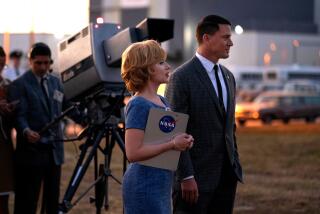Sea of Virtuality
- Share via
One small keystroke for man will soon be one virtual leap for mankind.
In July 1999, digital artist Benjamin Britton plans to follow in the footsteps of Neil Armstrong, and everyone is invited. Britton, a professor of fine arts at the University of Cincinnati, is orchestrating “Moon,” a multimedia extravaganza to take place on big screens around the world honoring the 30th anniversary of the first moon landing.
“On that evening, we’ll have a community gathering on the moon, with the generation that watched when we first went there and with the generation that never experienced it,” Britton says.
Partially funded with a $1-million grant from the University of Cincinnati and the Ohio Board of Regents, the project merges an interactive digital videodisc, a television special and Internet access. The “Moon” DVD-ROM will contain archival footage of the space missions, interviews with the astronauts and a virtual-reality map of the lunar landscape.
Audience members will watch a TV documentary and then, as Britton says, “go live to the virtual moon” by accessing a “mutual reality” online simulation via the DVD-ROM and a modem.
“Imagine one of the astronauts, who was actually there, giving a guided tour in virtual reality to convey some of the thoughts and impressions that were going through his head,” says Britton, who says he’s received a warm response from NASA, the European Space Agency and the Russian and Japanese space programs.
Working alongside astronauts and computer-savvy creative types enables Britton to meld his two passions, art and science. Is it also a chance for the somewhat starry-eyed professor to reignite interest in his lifelong dream of immigrating to an off-world colony?
“I’m not doing a sales pitch for outer space at all,” Britton says. “I’m mostly interested in the cosmological aspect of this. What’s the moon about for us? It’s not just about crew-cutted people from the 1960s going there. What does it mean that we stepped upon it? If you have art, it’s something you can care about. And if you have science, it’s something you can believe.”
Britton’s last major artwork also explored the intersection of science and culture. The critically acclaimed project enabled individuals to wander through a high-resolution virtual reality model of the prehistorically painted Lascaux cave in France.
But the technology, Britton points out, is never the message of his work. His art simply allows the public to use the tools of today to experience the wonder of the past.
“As people have known for thousands of years, the moon has a pull,” Britton says. “Otherwise, why would we have gone there in the first place? I want to get in touch with that physical and emotional pull.”
More to Read
The biggest entertainment stories
Get our big stories about Hollywood, film, television, music, arts, culture and more right in your inbox as soon as they publish.
You may occasionally receive promotional content from the Los Angeles Times.










